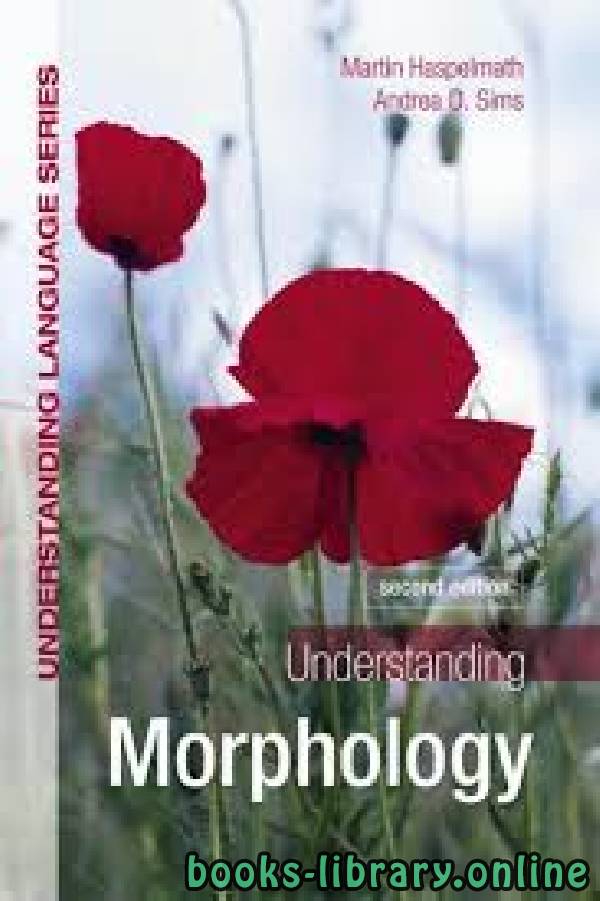📘 قراءة كتاب Understanding Morphology 2nd edition أونلاين


هذا القسم يحتوي علي كل ما يخص بعلم الصرف
يتوفر علم الصرف على تبيان تأليف الكلمة المفردة بتبيان وزنها وعدد حروفها و حركاتها و ترتيبها، و ما يعرض لذلك من تغيير وحذف، وما في حروفها و حركاتها و ترتيبهما، وما في حروف الكلمة من اصالة و زيادة.
يقتصر مجال دراسات الصرف على الأسماء المتمكنة (المعربة) و الافعال المتصرفة (غير جامدة).
أما الحروف و مبنيات الأسماء و جوامد الافعال، فلا تدخل في مجال دراسته و أبحاثه.
يُعرَفُ الصرف أيضا بعلم التشكل (باللاتينية: Morphologia). والصرف لُغَةً هو التغير والتحويل ومنه تصريف الرياح أي تغيير وجهتها من مكان لآخر.
In linguistics, morphology (/mɔːrˈfɒlədʒi/) is the study of words, how they are formed, and their relationship to other words in the same language. It analyzes the structure of words and parts of words, such as stems, root words, prefixes, and suffixes. Morphology also looks at parts of speech, intonation and stress, and the ways context can change a word's pronunciation and meaning. Morphology differs from morphological typology, which is the classification of languages based on their use of words, and lexicology, which is the study of words and how they make up a language's vocabulary.]
While words, along with clitics, are generally accepted as being the smallest units of syntax, in most languages, if not all, many words can be related to other words by rules that collectively describe the grammar for that language. For example, English speakers recognize that the words dog and dogs are closely related, differentiated only by the plurality morpheme "-s", only found bound to noun phrases. Speakers of English, a fusional language, recognize these relations from their innate knowledge of English's rules of word formation. They infer intuitively that dog is to dogs as cat is to cats; and, in similar fashion, dog is to dog catcher as dish is to dishwasher. By contrast, Classical Chinese has very little morphology, using almost exclusively unbound morphemes ("free" morphemes) and depending on word order to convey meaning. (Most words in modern Standard Chinese ["Mandarin"], however, are compounds and most roots are bound.) These are understood as grammars that represent the morphology of the language. The rules understood by a speaker reflect specific patterns or regularities in the way words are formed from smaller units in the language they are using, and how those smaller units interact in speech. In this way, morphology is the branch of linguistics that studies patterns of word formation within and across languages and attempts to formulate rules that model the knowledge of the speakers of those languages.
Phonological and orthographic modifications between a base word and its origin may be partial to literacy skills. Studies have indicated that the presence of modification in phonology and orthography makes morphologically complex words harder to understand and that the absence of modification between a base word and its origin makes morphologically complex words easier to understand. Morphologically complex words are easier to comprehend when they include a base word.[6]
Polysynthetic languages, such as Chukchi, have words composed of many morphemes. The Chukchi word "təmeyŋəlevtpəγtərkən", for example, meaning "I have a fierce headache", is composed of eight morphemes t-ə-meyŋ-ə-levt-pəγt-ə-rkən that may be glossed. The morphology of such languages allows for each consonant and vowel to be understood as morphemes, while the grammar of the language indicates the usage and understanding of each morpheme.
The discipline that deals specifically with the sound changes occurring within morphemes is morphophonology.
Contents
1 History
2 Fundamental concepts
2.1 Lexemes and word forms
2.1.1 Prosodic word vs. morphological word
2.2 Inflection vs. word formation
2.3 Types of word formation
2.4 Paradigms and morphosyntax
2.5 Allomorphy
2.6 Lexical morphology
3 Models
3.1 Morpheme-based morphology
3.2 Lexeme-based morphology
3.3 Word-based morphology
4 Morphological typology
5 Examples
6 Application
Understanding Language Series
Series Editors: Bernard Comrie and Greville Corbett
Understanding
Morphology
2nd edition
Martin Haspelmath
Max Planck Institute for Evolutionary Anthropology
Andrea D. Sims
The Ohio State University
Contents
Preface to the second edition xi
Preface to the first edition xiii
Abbreviations xv
1 Introduction 1
1.1 What is morphology? 1
1.2 Morphology in different languages 4
1.3 The goals of morphological research 6
1.4 A brief user’s guide to this book 9
Summary of Chapter 1 11
Further reading 11
Comprehension exercises 12
2 Basic concepts 14
2.1 Lexemes and word-forms 15
2.2 Affixes, bases and roots 19
2.3 Morphemes and allomorphs 22
Summary of Chapter 2 27
Appendix. Morpheme-by-morpheme glosses 27
Comprehension exercises 29
Exploratory exercise 30
3 Rules 33
3.1 Morphological patterns 34
3.1.1 Affixation and compounding 34
3.1.2 Base modification 35
3.1.3 Reduplication 38
3.1.4 Conversion 39
3.1.5 Outside the realm of morphology 40
viâ•… C O N T E N T S
3.2 Two approaches to morphological rules 40
3.2.1 The morpheme-based model 41
3.2.2 The word-based model 46
Summary of Chapter 3 54
Further reading 54
Comprehension exercises 55
Exploratory exercise 56
4 Lexicon 60
4.1 A morpheme lexicon? 61
4.2 A strict word-form lexicon? 66
4.3 Reconciling word-forms and morphemes 70
Summary of Chapter 4 75
Further reading 75
Comprehension exercises 76
Exploratory exercise 77
5 Inflection and derivation 81
5.1 Inflectional values 81
5.2 Derivational meanings 86
5.2.1 Derived nouns 87
5.2.2 Derived verbs 88
5.2.3 Derived adjectives 89
5.3 Properties of inflection and derivation 89
5.3.1 Relevance to the syntax 90
5.3.2 Obligatoriness 92
5.3.3 Limitations on application 93
5.3.4 Same concept as base 93
5.3.5 Abstractness 94
5.3.6 Meaning compositionality 94
5.3.7 Position relative to base 95
5.3.8 Base allomorphy 96
5.3.9 Word-class change 96
5.3.10 Cumulative expression 98
5.3.11 Iteration 98
5.4 Dichotomy or continuum? 98
5.4.1 Inherent and contextual inflection 100
5.5 Inflection, derivation and the syntax-morphology interface 102
5.5.1 The dichotomy approach and split morphology 102
5.5.2 The continuum approach and single-component
architecture 105
Summary of Chapter 5 106
Appendix. Notation conventions for inflectional values 107
سنة النشر : 2010م / 1431هـ .
حجم الكتاب عند التحميل : 2.7MB .
نوع الكتاب : pdf.
عداد القراءة:
اذا اعجبك الكتاب فضلاً اضغط على أعجبني و يمكنك تحميله من هنا:

شكرًا لمساهمتكم
شكراً لمساهمتكم معنا في الإرتقاء بمستوى المكتبة ، يمكنكم االتبليغ عن اخطاء او سوء اختيار للكتب وتصنيفها ومحتواها ، أو كتاب يُمنع نشره ، او محمي بحقوق طبع ونشر ، فضلاً قم بالتبليغ عن الكتاب المُخالف:
 قبل تحميل الكتاب ..
قبل تحميل الكتاب ..
يجب ان يتوفر لديكم برنامج تشغيل وقراءة ملفات pdf
يمكن تحميلة من هنا 'http://get.adobe.com/reader/'


 منصّة المكتبة
منصّة المكتبة 